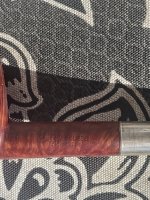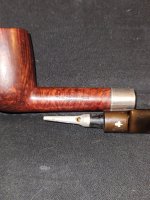This is severely complicated and jguss is correct. This is the earlier result of the beginning of some massive mergers. A non-Kaywoodie Drinkless before it all came together. Definitely 1920s era.
Here is one summary, not written by me:
It's tough to know where to begin with this one. Kaywoodie and its related entities form a story fully as convoluted as the Cadogan analogue on the other side of the Atlantic. Worsening the tangle, Kaywoodie and Cadogan held interlocking interests in subsidiaries at one point to facilitate each of their export sales. To a large extent the Pipedia version is correct, as far as it goes, although details are sometimes seriously wrong. I've put off doing anything about it because of the complexity and multiplicity of people, companies, and events. I actually started a draft a dozen years ago but had to set it aside due to more pressing obligations (i.e. earning a living); it'll be a retirement project assuming I live that long. For now I'll make a few points and provide an extremely brief chronology. Hopefully this will provide a little incremental clarity.
First the prefatory remarks:
-it's almost impossible to make sense of this mess without know the individuals involved; each entity brought its own people into the mix, and in many cases they (or their children) played key roles
-think of an org chart of hideous complexity with shifting lines leading from one box to another, criss-crossing like cooked spaghetti dumped on the floor. To really understand what happened you need to create multiple parallel timelines showing when companies were created, merged, bought, and sold until you wind up with the SM Frank of today.
Here's a grossly simplified narrative. Each of these entities could easily be the subject of a chapter in a tediously long book:
-The oldest business is KB&B (1851), the key men were Leopold Kaufmann and Solomon Bondy, later joined by Leopold's brother Gottlieb Kaufmann
-Next came Reiss Bros & Co (c. 1886); the key men were brothers Julius and Otto Reiss (another brother named Nathan was in the tobacco leaf business), plus their sister Marie Reiss' husband Nathan Burger, and most importantly later on Marie's son Jacob (later Anglicized to John) David Burger; he played the pivotal role in the industry consolidation which happened a few decades later
-Next comes the Premier Briar Pipe Co (June 13, 1913), formed by Carl Hirsch (who immediately prior to this foray into pipemaking on a large scale had started another company which had gone bankrupt about the same time this venture was launched). Carl's nephew Rudolph Hirsch was to play an important leadership role in the combined businesses many years later
-Reiss-Premier Pipe Co was formed as the result of a merger between Reiss Bros and Premier Briar Pipe in 1920. The deal was orchestrated by John Burger (by this time his father and two uncles, the three original partners in Reiss Bros, were long dead) who ran the combined entity
-In August 1926 Reiss-Premier purchased a controlling interest in KB&B and operated it as "an associate company". Another "associate company" at that time was the Civic Premier Pipe Co, which was designated as the American representative of the UK's Civic Pipe Company, Ltd (the relationship between Cadogan and Reiss-Premier et al is worth a chapter of its own; this arrangement of course accounts for the appearance of the made-in-England Drinkless pipes appearing at this time). In the wake of the KB&B deal Reiss-Premier grew to 300 workers
-Five months before the crash of 1929, in April of that year, Burger negotiated a partial sale of Reiss-Premier to United Cigar Stores of America under David Schulte in the form of a stock swap. United Cigars purchased 49% of the company for equity in United Cigar valued at $735,000
-Meanwhile there is a parallel path involving the progress of Samuel Morris Frank (S. M. Frank & Co est. 1900) as he grew his business both organically and through acquisition. Two examples of the latter are the purchase of Manhattan Briar in 1922 from American Tobacco, and more significantly of Wm Demuth & Co bought from D. A. Schulte Inc (a subsidiary of the Schulte Retail Store Corp) in 1937. Here again the story is complicated but in brief Schulte had bought Demuth in the Spring of 1927. By the mid Thirties the Depression had taken a severe toll on Schulte's business and it was in financial distress. A legal reorganization that started in 1936 continued into 1937, in which year Schulte sold Demuth to S. M. Frank to raise some much needed cash
-After the acquisition Frank, driven at least in part by an impending loss of its own factory due to eminent domain, promptly consolidated its production into the Demuth Richmond Hill facility
-Meanwhile back at Reiss-Premier when John Burger died in 1944, Rudolph Hirsch wound up winning the succession contest to run the combined businesses
-Just six years later Associated Products, a Chicago manufacturer of deodorants, bought Reiss-Premier at the very end of 1950. The reasons for this are hazy to me; I suspect but can't prove it was yet another example of the unrelated diversification strategy which led to the creation of so many disparate conglomerates in the years after WW2 (e.g. ITT, GE, etc)
-Associated Products held the business for five years before selling it to S. M. Frank in 1955, which retains Reiss-Premier to this day
So there you have a light sketch of how the consolidation of most of the major American pipe manufacturers took place. I'll wrap up by making two smaller points. First, Kaywoodie as a brand dates to approximately March 1919. It was a deliberate renaming of the Dinwoodie, which itself dated from November 1916. Text from an ad to the trade dated March 1 1919: "In order to associate the name of the Dinwoodie pipe with the name of our house, it will hereafter be known as the Kaywoodie. Kay will serve to identify this superlative Italian Bruyere pipe with our name, KAUFMANN BROS. & BONDY." Second, why people refer to the Drinkless as a patent is unclear to me. While filed with the US Patent Office the actual grant (213598) is clearly for a trademark, i.e. the use of the word "Drinkless" in this context, not any internals to the pipe.
In reviewing the above I realize for those interested in Kaywoodie it is entirely to short, while for those who are not it must be a snooze fest of epic proportions. I apologize to both groups.














